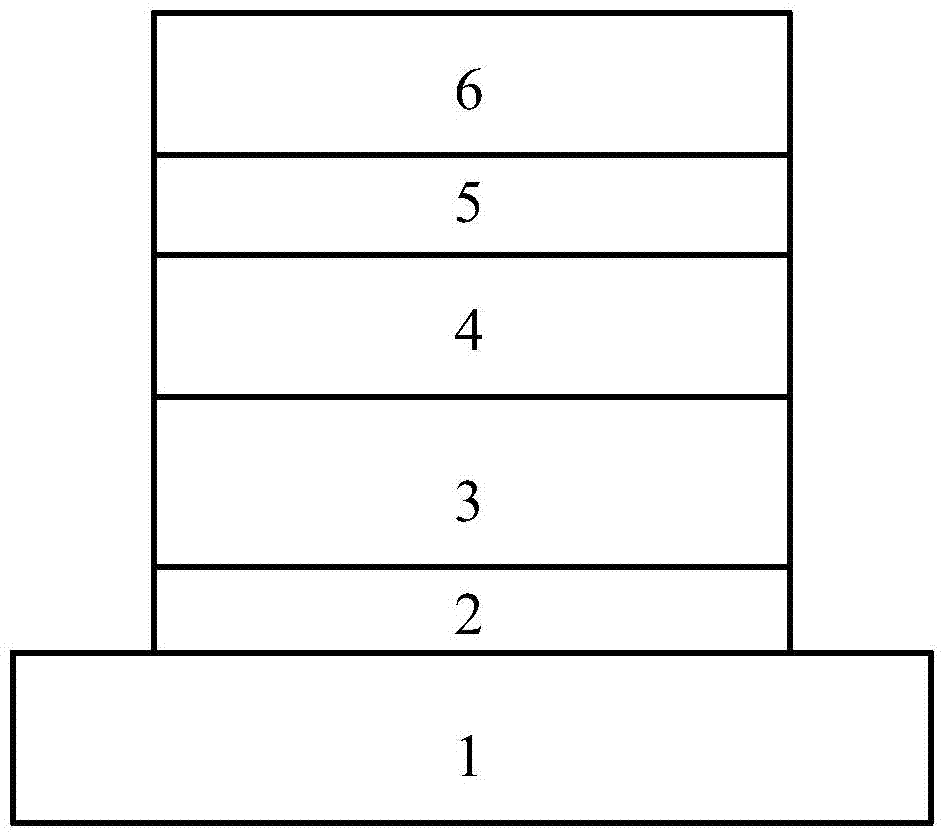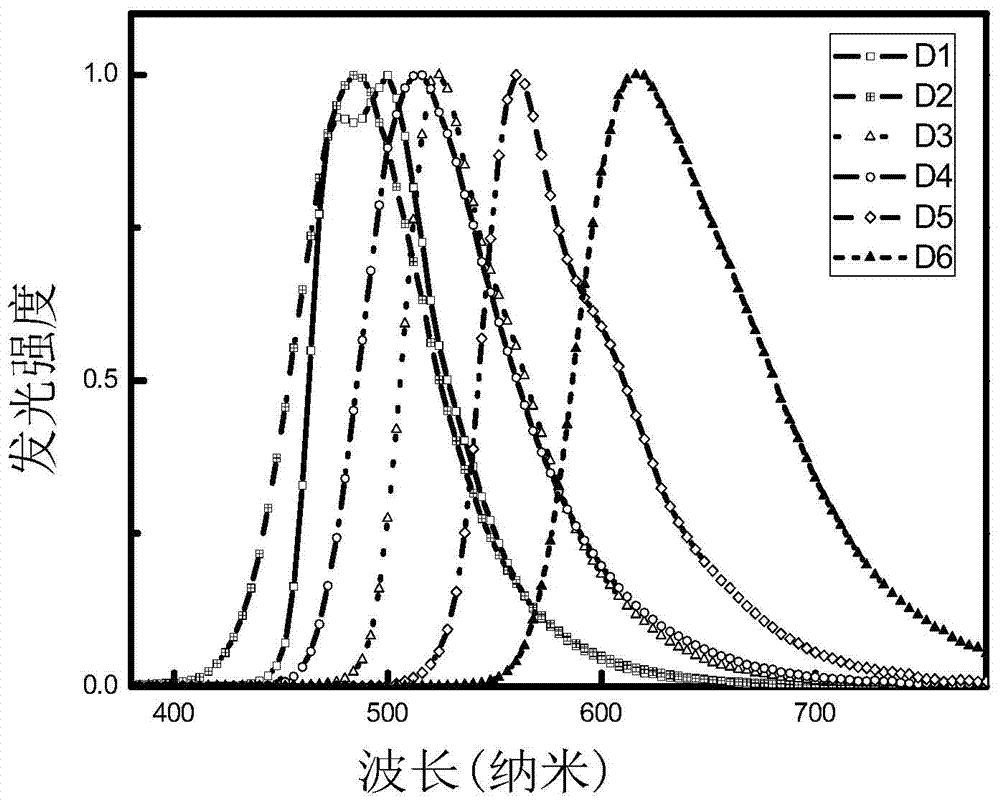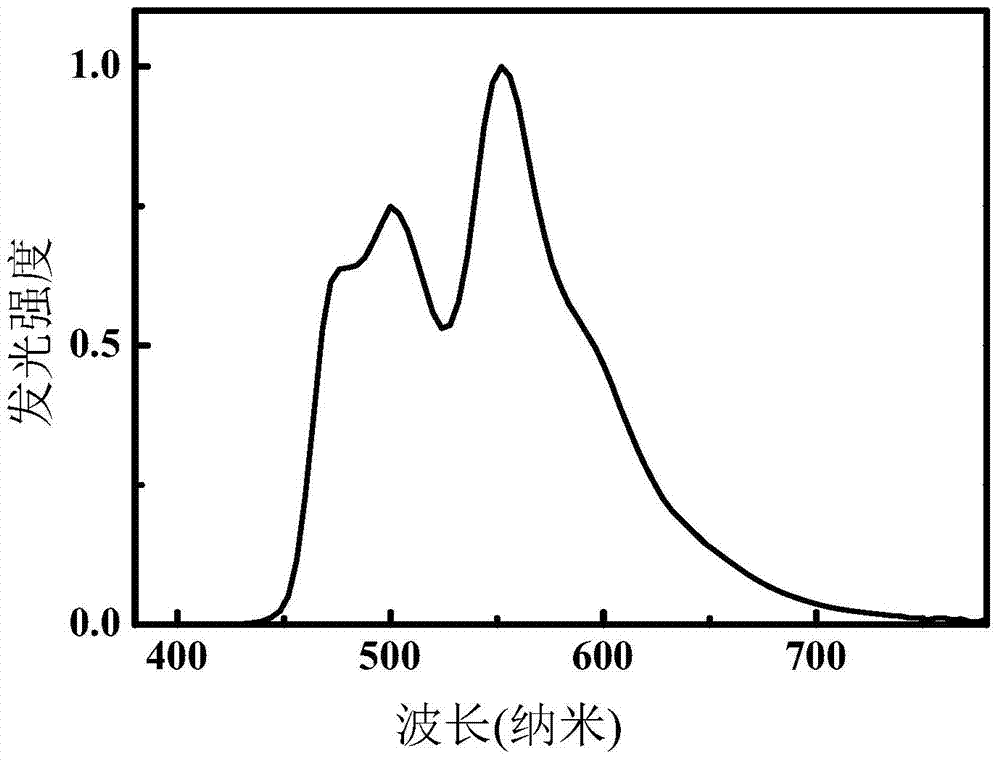Electroluminescent materials with bipolar carrier transport properties and their applications as host materials for organic electroluminescent devices
An electroluminescent material, electroluminescent device technology, applied in the direction of luminescent materials, electro-solid devices, electrical components, etc., to achieve the effect of saving preparation cost, facilitating mass production, and high-efficiency electroluminescent performance
- Summary
- Abstract
- Description
- Claims
- Application Information
AI Technical Summary
Problems solved by technology
Method used
Image
Examples
Embodiment 1
[0032]Preparation of electroluminescent materials with the following structural formula
[0033]
[0034] Add 0.30g of 4-bromophenyl-N-benzimidazole, 0.65g of 3,5-dicarbazolyl-1-boronic acid and 0.03g of tetrakis(triphenylphosphine)palladium(0) into a 100mL flask, followed by Inject 40mL of 1,4-dioxane and 2.7mL of 1mol / L sodium carbonate aqueous solution, reflux for 48 hours under the protection of nitrogen, after cooling to room temperature, add distilled water, sequentially extract with chloroform, dry over anhydrous magnesium sulfate, filter, Spin-dried, the obtained crude product was subjected to column chromatography (a mixture of ethyl acetate and petroleum ether with a volume ratio of 2:1 was used as the eluent) and spin-dried to obtain a white powdery electroluminescent material. Its chemical name is It is 4'-N-benzimidazolyl-3,5-(9H)dicarbazolylbiphenyl (abbreviated as Host1), the yield rate is 63%, the triplet state energy level is 2.71eV, and the structural char...
Embodiment 2
[0036] Preparation of electroluminescent materials with the following structural formula
[0037]
[0038] In Example 1, the 4-bromophenyl-N-benzimidazole used will be replaced with an equal mass of 2-bromophenyl-N-benzimidazole, and the other steps are the same as in Example 1 to obtain a white powdery electrode Luminescent material, its chemical name is 2'-N-benzimidazolyl-3,5-(9H) dicarbazolyl biphenyl (referred to as Host2), the yield is 60%, and the triplet energy level is 3.00eV , the structural representation data is: 1 H NMR (600MHz, CDCl 3 )δ (ppm): 8.14 (s, 1H), 8.08 (d, J = 7.7Hz, 4H), 8.01 (d, J = 8.1Hz, 1H), 7.76 (dd, J = 7.7, 1.4Hz, 1H) , 7.68-7.60(m, 4H), 7.55(d, J=7.6Hz, 1H), 7.47(d, J=1.9Hz, 2H), 7.41-7.36(m, 5H), 7.30-7.27(m, 5H ), 7.10 (d, J=8.2Hz, 4H); MS (ESI) m / z: 601 [M+H] + .
Embodiment 3
[0040] Preparation of electroluminescent materials with the following structural formula
[0041]
[0042] In Example 1, the 4-bromophenyl-N-benzimidazole used will be replaced by an equal mass of 3-bromophenyl-N-benzimidazole, and the other steps are the same as in Example 1 to obtain a white powdery electrode Luminescent material, its chemical name is 3'-N-benzimidazolyl-3,5-(9H) dicarbazolylbiphenyl (referred to as Host3), the yield is 62%, and the triplet energy level is 2.80eV , the structural representation data is: 1 H NMR (600MHz, CDCl 3 )δ(ppm): 8.35(s, 1H), 8.17(d, J=7.7Hz, 4H), 7.97-7.83(m, 6H), 7.74(t, J=7.8Hz, 1H), 7.60(d, J=8.2Hz, 6H), 7.46(t, J=7.6Hz, 4H), 7.36(dt, J=31.1, 7.4Hz, 6H); MS(ESI) m / z: 601[M+H] + .
PUM
| Property | Measurement | Unit |
|---|---|---|
| thickness | aaaaa | aaaaa |
| current efficiency | aaaaa | aaaaa |
| current efficiency | aaaaa | aaaaa |
Abstract
Description
Claims
Application Information
 Login to View More
Login to View More - R&D
- Intellectual Property
- Life Sciences
- Materials
- Tech Scout
- Unparalleled Data Quality
- Higher Quality Content
- 60% Fewer Hallucinations
Browse by: Latest US Patents, China's latest patents, Technical Efficacy Thesaurus, Application Domain, Technology Topic, Popular Technical Reports.
© 2025 PatSnap. All rights reserved.Legal|Privacy policy|Modern Slavery Act Transparency Statement|Sitemap|About US| Contact US: help@patsnap.com



